In a growing economy, a frequent question that is asked is whether the workforce is truly inclusive. In India, we have made significant progress in the education levels of Scheduled Castes, Scheduled Tribes and Other Backward Classes. But is the improvement reflected in employment and income potential?
In this fourth and final article in the workforce series, we explore the changes in the education and employment pattern of young urban Indian men (25-35 years) by focusing on the inclusiveness of opportunities by caste groups.
The well-established vast inequality in terms of income and wealth among Indian households belonging to different castes has often been discussed. But to truly capture the progress, if any, towards inclusiveness, we need to compare the outcomes for the younger age group. It is here that any impact of the affirmative public policies such as reservation and a general move towards breaking the caste barriers can be noticed. Further, the change is likely to be faster in urban areas and among young men.
We use data from the Employment and Unemployment Survey of National Sample Survey Organisation (NSSO) for 2004-05 and from the Periodic Labour Force Survey (PLFS) for 2017-18. Indians are divided into four broad categories in official statistics — Scheduled Caste (SC), scheduled Tribe (ST), Other Backward Class (OBC), and General Category (GC), which includes the ‘upper’ castes. Among the age group of 25 to 35 years in urban India, OBC and GC accounted for around 40 per cent each, along with SC population of around 16 per cent and ST less than 3 per cent in 2017-18.
Also read: More young urban Indian men appear to be studying longer, not looking for jobs: New research
Uniform rise in education levels
Over the last decade, the levels of education across all social groups have increased in urban India. The education pattern of those belonging to OBC is now similar to GC (Graph 1).
Graph 1
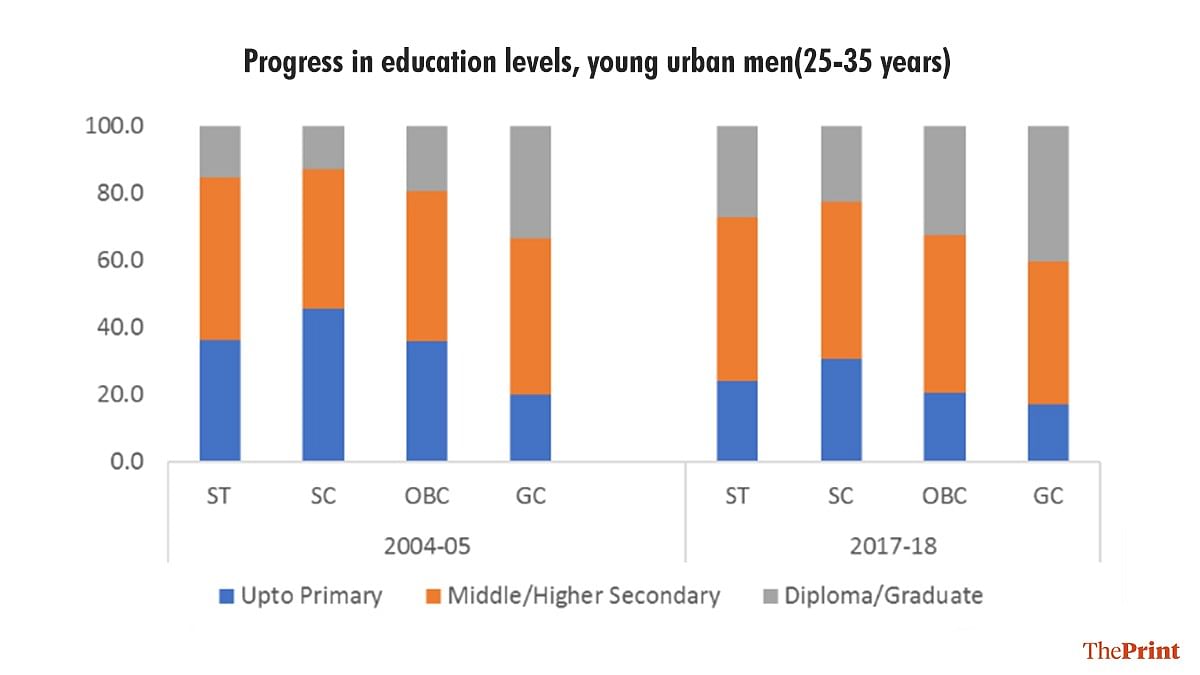
There is also a sharp increase in the proportion of young men who are educated beyond primary schooling among SC and ST. Some of the increase in higher education levels could be a result of the affirmative action by successive central and state governments such as reserving a specified number of seats in higher education institutions and a lower entry threshold for students from certain castes.
Increase in employment levels, inclusiveness
The next obvious question to ask is: has a rise in education levels led to a change in the employment pattern among young men belonging to different castes?
Graph 2
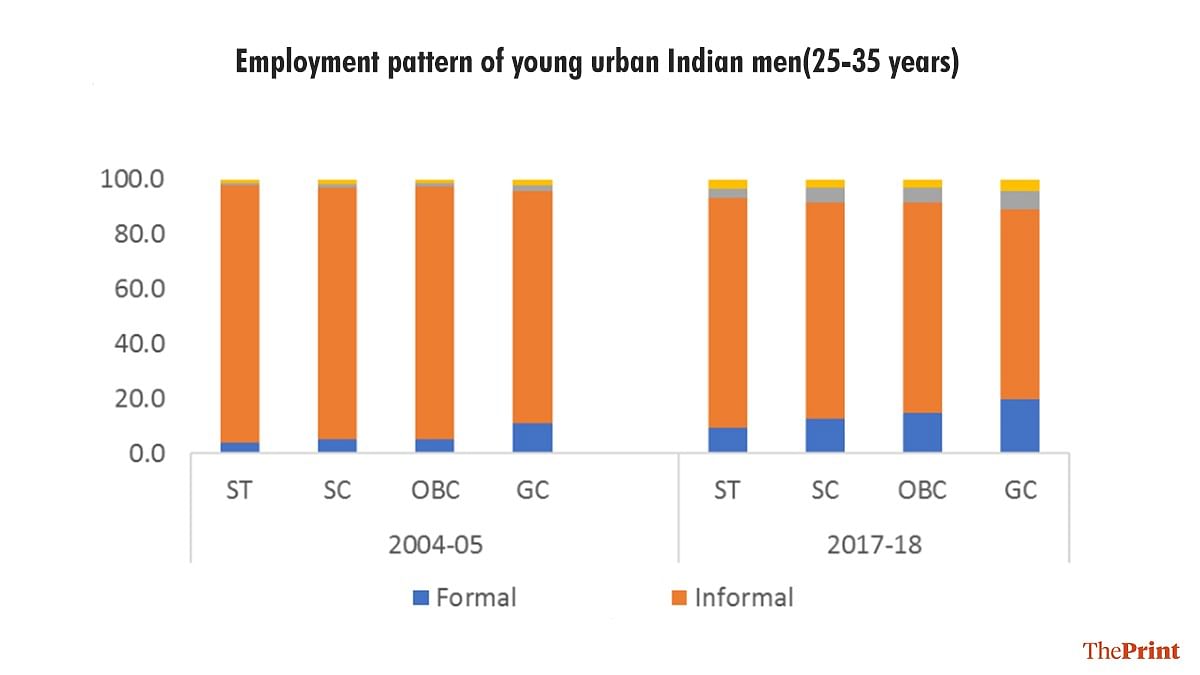
In the age group of 25-35 years, virtually all Indian men work. Compared to 2004-05, the share of formal employment has increased among all social groups and ranged between 20-28 per cent (Graph 2). The largest increase in formal employment of 10 percentage points can be seen in the OBC and GC. While inclusiveness of the job market may have appeared to have increased, it could partly be a forced affirmative outcome of the job quota in the public sector, including in banks and administration.
Also read: In ‘progressive’ Tamil Nadu, Karnataka, only 1 in 5 young urban women in paid work
Real estate, IT services more inclusive than others
A more genuine increase driven by increasing education levels, accompanied by more openness towards inclusivity, should be reflected in the job pattern of high skill service sectors such as real estate and business services (including IT/ITES).
Graph 3
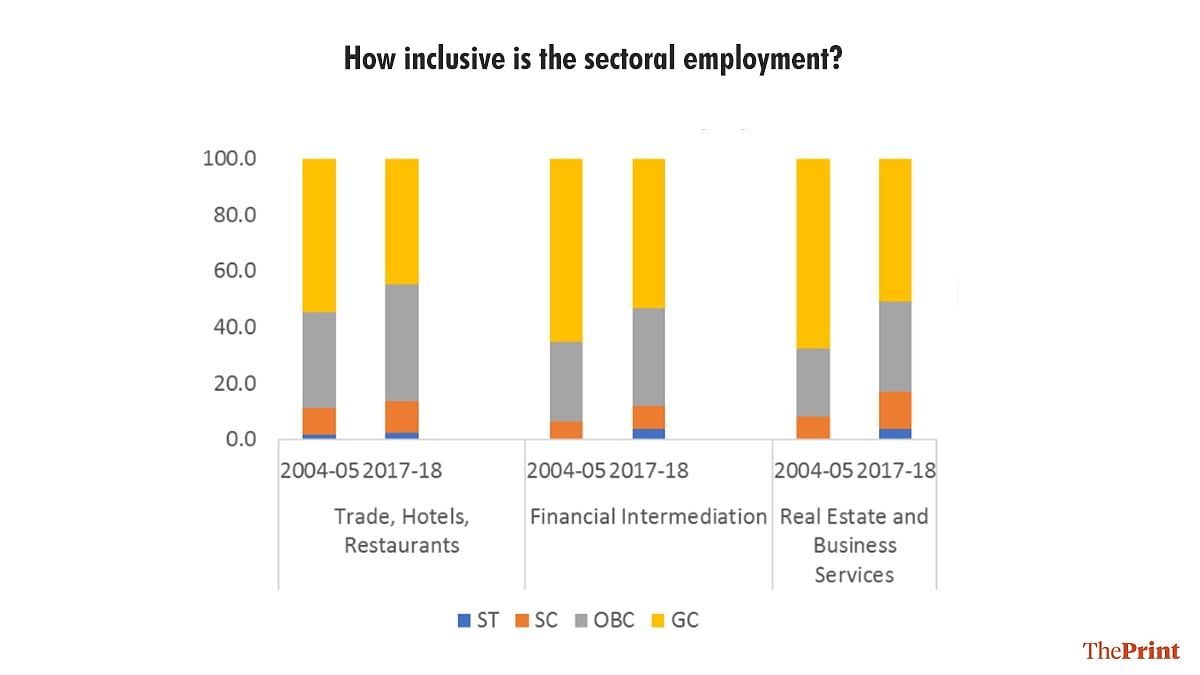
Our analysis shows that among the Indian men between the age of 25 and 35 years employed in urban regions in the real estate and business services, the share of OB, SC, ST together had risen close to half by 2017-18 and, specifically, the representation of young men from OBC has risen sharply to 35 per cent (Graph 3).
If this trend were to continue, the employment pattern in the real estate and business services by the end of the decade would be similar to the population shares of a different caste group. However, the share of the sector in total employment remains relatively low at 5.3 per cent in urban India and thus replicating the success here in other parts of the economy would be essential.
Bridging the caste gap in jobs?
While the employment pattern in India has become more inclusive in terms of industrial representation, has the caste gap in terms of occupations narrowed? Traditionally, SC and ST were locked into unskilled elementary occupations such as street vendors and low-skilled labourers in industry and services such as cleaners. Over time, however, caste can also play an important role in occupational convergence. Once the caste-based networks are formed in urban areas, they facilitate the occupational mobility of historically disadvantaged castes.
Graph 4
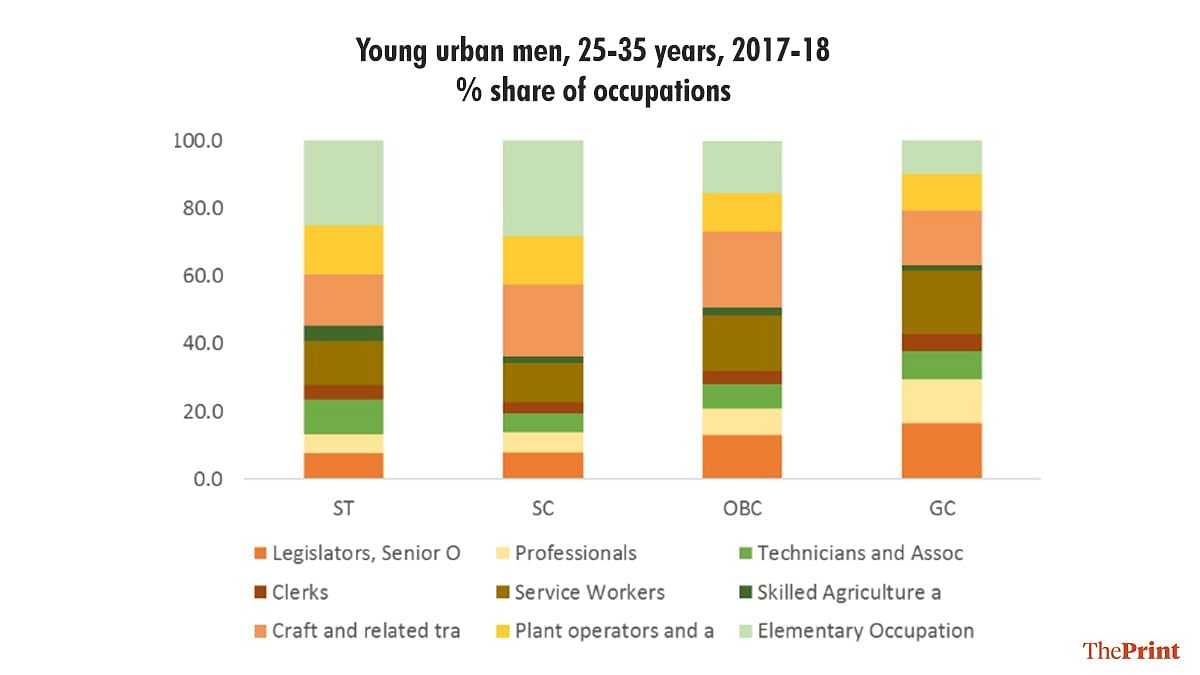
To explore this, we looked at the share of different occupations within each social group in 2017-18. Once again, the occupations of OBC and GC have largely become similar, barring the share of professionals (Graph 4).
Also read: Manufacturing or high-tech? This is what India’s most prosperous states focus on
Income levels higher for upper caste
Finally, we explored the caste-based differences in income levels among young urban men by their completed years of formal schooling. Do the returns to education differ among the caste groups?
Graph 5
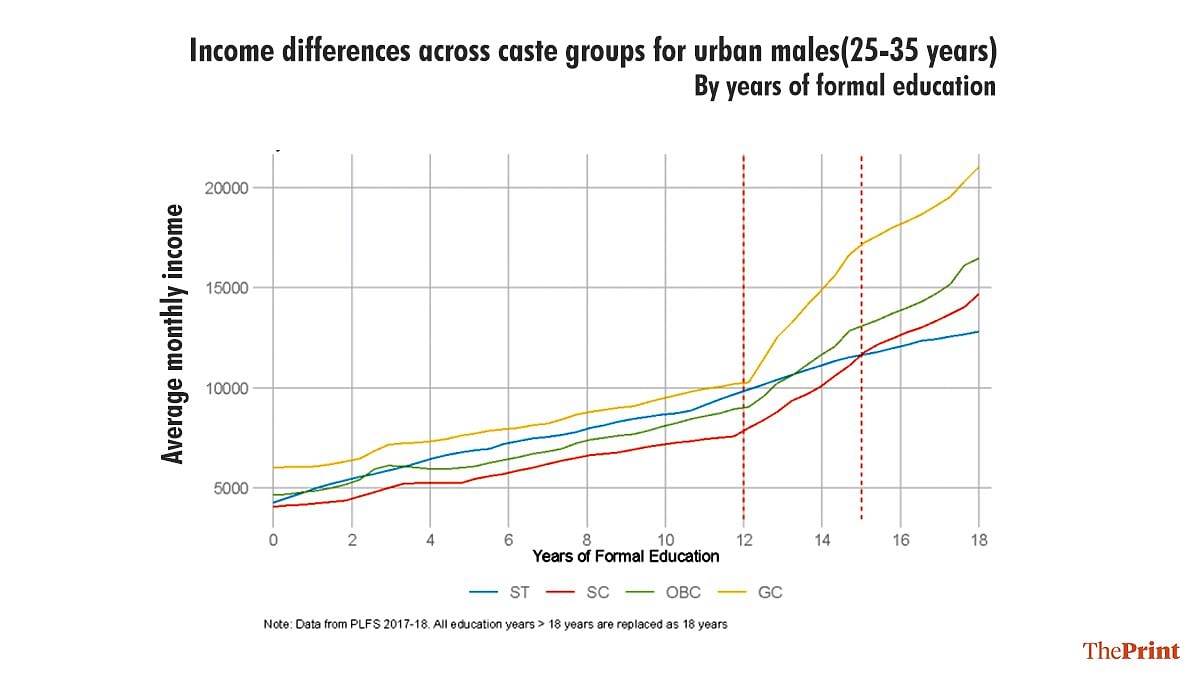
While the income level of a young person belonging to GC continues to remain higher than other caste groups at all levels of education, the income differences become larger among young adults with tertiary education (graduate or post-graduate levels). (Graph 5).
In sum, we find that while progress has been made by all, young men from OBCs have seen a larger catch-up. The returns to higher education in terms of wage disparities in different caste groups however, remain significant. Closing the caste gap in education, jobs and incomes of young men continues to be a work in progress in urban areas.
New study finds this caste group benefitted most from rising education levels in India
This is the fourth and final article in the workforce series. Read all the articles here.
Vidya Mahambare is Professor of Economics, Great Lakes Institute of Management. Sowmya Dhanaraj is Assistant Professor of Economics, Madras School of Economics. Sankalp Sharma is post-graduate student, Madras School of Economics. Views are personal.


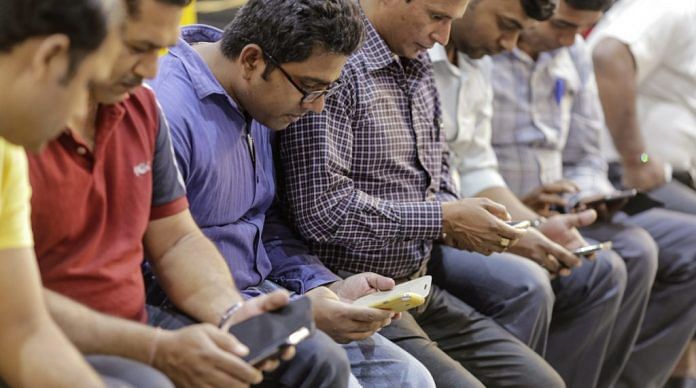


Can journalism now go beyond casteism and actually focus on the economically backward strata of the society? The media can play a huge role in taking India away from caste-based differentiation and towards equal opportunities to new classes of suppressed society, such as economically backward, low access to infrastructure, LGBTQ, etc. Instead the media just keeps fanning the flames in the caste vs. caste debate and then writes articles about how the Indian society is divided.
According to author’s GC is 40%. Take away minorities then Hindu GC is only 20% of overall population. Take away some large castes like Marathas, Gujjars etc from that 20% Hindu GC then it could well that in most states only 5-10% could be actual upper castes. So this 5-10% has access to 50% of seats in govt desk jobs and govt college admissions. i feel the message from some commenters is to keep the white collar jobs as an upper caste preserve as they feel they are best suited for it.
Well done . Very good analysis.
They should have put the population %, how 15 are doing so well…and over represented anad overpaid.
I am not sure if GC in the survey included Muslims, Christians, Sikhs and other minorities as they cannot avail of reservations. If it did include them, the survey should publish breakdown in GC between upper caste Hindus and the various minorities.
Well explained. Disparity between upper class and lower class remains.
But most of these reservation benefits in education n emplyement are used by urban population
Just yesterday The Hindu concluded three day series report that said entirely opposite. I figure that you must have read that and came up with way to counter.
Such an amazing craftsmanship with data! Just yesterday The Hindu concluded three day series report that said entirely opposite. I figure that you must have read that and came up with way to counter. Shame.
The caste gap is being closed at the cost of livelihoods of the so-called upper castes. The so-called lower castes are being given the traditional jobs of the so-called upper castes while the upper caste are now doing what was earlier the job domain of the lower castes. At the same time, the legal protections available to the lower castes are not available to the upper castes thereby rendering them vulnerable to exploitation and oppression. In short, while the original caste system aimed to create harmony between various socio-economic groups, the current system aims to take away that harmony and empower the former lower castes at the cost of the former upper castes. The Indian government for example, provides free education to SC/ST from school till university level but has no scheme for poor people from the upper caste who are then forced to live in poverty all their life. Then social scientists and government wonders why there is no social harmony. It is painful to see one’s community members descending into poverty because the State has deemed that they do not deserve any support just because their forefathers were supposedly privileged and other community members rising at their cost. You cannot artificially induce social harmony by robbing Peter and make him poor to pay Paul and make him rich and powerful.
Make use of EWS quota. You have no reason to feel bitter now. Besides EWS cutoff is similar to OBC cutoff marks in admissions. Note that the 10% quota for upper castes is way more than upper caste numbers in the population.
Data shows 10% of GC in elementary occupations. i am hard pressed to believe that those in GC esp upper castes would be street vendors or sanitary workers. Need better and more detailed data behind the interpretation of the charts.
OBC creamy layer (high income and well landed family) cannot get reservation benefits. Only non-creamy layer falls under 27% OBC quota.
There are fee waivers in academic central govt institutions for economically backward students.
For instance in IIT and NIT which are engineering institutions:
Students whose parents earn less than Rs 1 lakh can get full remission of the fee.
If the family earns between Rs 1 lakh and 5 lakh per annum, they can get a remission of two-third of the fee.
The point regarding “harmony amongst socio-economic groups” with the original caste system – but was the caste system beneficial as far as literacy and job mobility was concerned?
In earlier centuries did the caste system help in improving the literacy of the lower castes? No. Very few among these groups would have been able to read/write even in Indian languages (leave Sanskrit) until the British arrived. Education in whatever form it existed was only for the elites until then and it was mostly a “religious” type of education – be it Vedic or Islamic, overseen by the kings and the ruling classes.
The literacy rate in India was a mere 3.2% in 1872, It was the British who democratised education and set up schools and colleges open to all. Literacy levels improved thus to 15% in 1951. With reservations, it is not just about literacy but also about the level of education – so now lower castes have got better chances at job mobility, they have the chance to do white collar work now.
Clearly decades of reservation has made minimal impact. Scrap reservation policies and instead provide equitable opportunities for lower income strata of people rather than on the basis of caste. Caste based reservations’ benefits have been reaped by select few government employees and their families generation after generation.
It’s interesting that “sectoral employment” graph shows general category takes 50% of the jobs, which seems disproportionate to their population.
Also note that in “percent share of occupations” graph, there is not much difference show between GC and OBC’s across all occupations. But if you take actual population numbers of reservation categories ( pie chart for each skill) I am sure it will show a totally different picture – for instance number of OBC’s in elementary occupations will be way more than GC because of population proportion.
EWS quota satisfies the need for those with low income from upper castes. Government has created 8 lakhs annual family income limit to avail of this quota so there is no need of an income based reservation at all.
It was indeed a brilliantly put together series of articles. Completely unbiased and based on facts and data. Props to the writer for not subverting the data to make a false narrative.
It is impossible to enslave a educated person
Till now I not able to make a connection between Social Backwardness of OBC caste with SCs and STs and the superfoolish concept of Bahujana …….In my state OBC dominated castes like Yadav , Kurmi , Baniya , Ansaris are very much emopowerd (socio economic) than SCs but I always listen their combined social awtar called Bahujana …..We need to Bycott these narratives
P.S :- I’m Brahmin
Creating a false impression with just Using urban data. The real india is in rural villages where more than 70% live. This study completely ignores them.
No it does not, first of all these surveys are conducted at national level including every city and village. If you study the article you’ll also find information regarding agriculture, plant workers and other fields, so kindly cast away your biased specs.
EDUCATION can break down the caste system …………… Good job the Print
This is such a wonderfully researched article with statistics. Good job Print